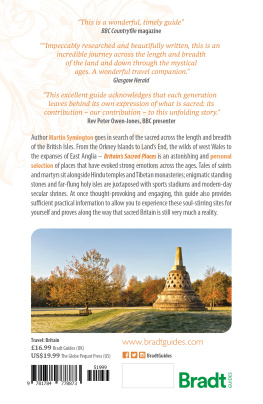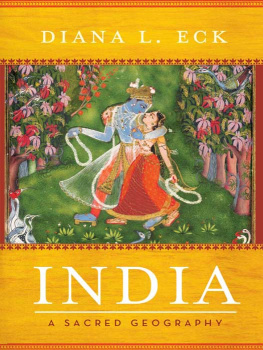W ith utmost appreciation, I would like to thank my editor, Andrea Norville, for bringing me this project that connects so deeply with my heart and for holding the vision and demonstrating infinite patience, guidance, and skillful editing. I would also like to express my appreciation to everyone at Adams Media who worked so diligently to bring this project to fruition.
I also would like to thank Katerina Lorenzatos Makris for her valuable insights for this book and for accompanying me to Athens, her ancestral island of Kefalonia, Ptmos, and Turkey. And thanks to Carlos Carvajal for showing me churches in the Caribbean.
INTRODUCTION
H umans have long sought sacred places to express their faith, find meaning, gain guidance, receive healing, mourn a loss, and experience renewal. Such places are as varied as the people who visit them. Judeo-Christians, for example, might visit sacred sites in the Middle East, such as the Holy Sepulchre that covers the locations of Jesuss Crucifixion, entombment, and Resurrection and is currently watched over by clergy from the Greek Orthodox, Syrian, Ethiopian, Armenian Orthodox, Coptic, and Roman Catholic churches.
Followers of Buddha might yearn to circumambulate Mount Kailash or visit the holy sites the Buddha claimed as sacred. Muslims might find themselves drawn to the holy cities of Medina, Mecca, and Hebron. A pilgrimage to learn about the ancient mysteries of Machu Picchu in Peru, or the energy vortexes of Sedona, Arizona, or the sacred stones of Stonehenge in England might appeal more to New Age followers. Native Americans, Wiccans, and pagans might prefer to seek sacred spaces in nature, like Mount Shasta in Northern California or Crater Lake in the Cascade Mountains of Oregon.
Holy environments, which are often associated with mysterious energies or special powers, can serve as oases for an arid heart or lift a spiritually yearning soul closer to the Divine. In sacred places, you can perform penance for spiritual purification, engage in a rite of passage, light a devotional candle, venerate a saint, meditate or reflect on some symbolism or traditional practice, pay homage to your ancestors, or simply offer a heartfelt prayer.
This book is your guide to 275 sacred places throughout the world. These hallowed sites range from hidden grottoes, natural springs, red-colored cliffs, and ancient stone circles to vaulted-ceilinged cathedrals, massive megaliths, stone pyramids, intricately carved temples, and totems. There are even entire towns, mountain ranges, seemingly endless rivers, and ancient forests and Iron Age ring forts that are considered sacred to followers of certain religious traditions.
Although we have worked diligently to provide accurate travel information, such information is subject to change. Please note that some sites are located in countries that are undergoing or have experienced civil unrest and political turmoil and may be problematic for tourists. Visit the U.S. Department of States site for international travel information and a list of specific countries with travel warnings or advisories at http://travel.state.gov. In addition, some historical data are subject to change as new evidence and research become available, and some of the religious and spiritual information is subject to change as well as to interpretation. The scriptural passages and religious/spiritual doctrines quoted and referenced in this book may have been taken from various versions of those sacred texts and oral annals. All of the sources we explored in compiling this book indisputably confirm, however, that these 275 places are among the most fascinating and sacred sites in the world today.
Explore your spirituality. Visit one or more of the many sacred sites in the world to pay respect, meditate, reflect, perform a ritual, or follow the ancient cycle of prayerthat is, praise, worship, and listen. Then let inspiration guide you into action. Repeat the cycle, inspired by the sanctity of the holy places you visit.
CHAPTER 1
LOVE, COMPASSION, DEVOTION
A love for humanity came over me, and watered and fertilized the fields of my inner world, which had been lying fallow, and this love of humanity vented itself in a vast compassion.
Georg Brandes (18421927),
Danish critic and scholar
1. Shrine of Rumi
KONYA, TURKEY
This is love: to fly toward a secret sky, to cause a hundred veils to fall each moment. First to let go of life. Finally, to take a step without feet.
Jalal al-Din Rumi (12071273), Persian poet and mystic
T he Sufi poet Rumi was so absorbed with his love for the Divine that he danced through the streets of medieval Konya, praying and whirling in ecstasy. Today, in the heart of this conservative city located three hours (by car) south of Ankara, the turquoise dome of Rumis mausoleum rises rapturously toward the heavens and its ornate interior pulsates with ethereal beauty while, over the citys din, the muezzin calls out adhn (call to prayer).
Whether you yearn to deepen your love for the Divine or to see Rumis resting place, the Green Dome, now known as the Mevlna Museum, is a sight to behold. The mausoleums towering walls, adorned with enameled reliefs and Islamic script, encircle the gold-draped tomb of Mevlna (Our Guide), as Rumi is called by the Whirling Dervish sect he inspired. An adjoining room displays ancient manuscripts, prayer beads, musical instruments, and other artifacts.
















